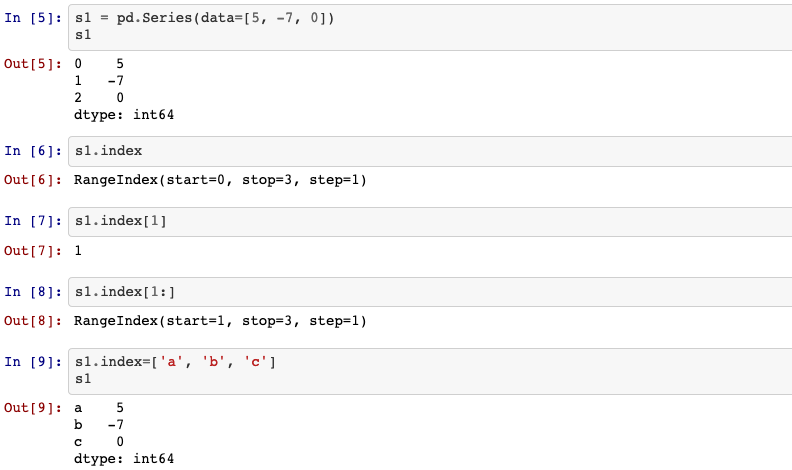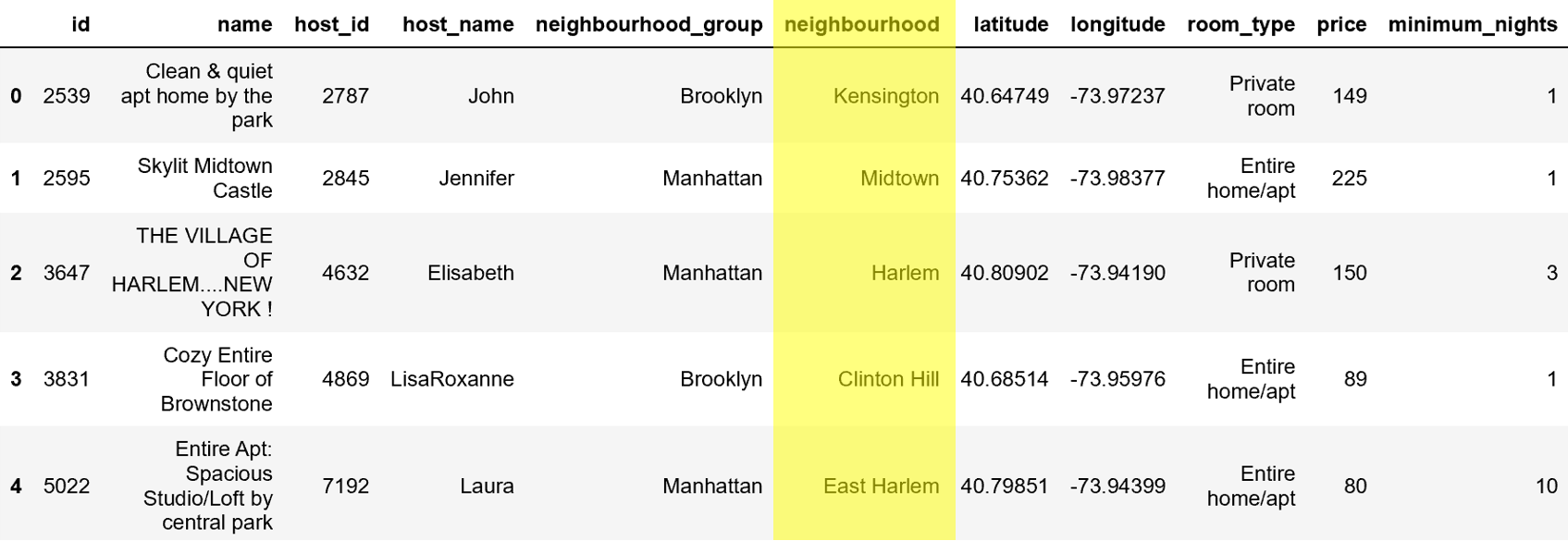38 pandas series get labels
Python Pandas - Series - Tutorialspoint A Series is like a fixed-size dict in that you can get and set values by index label. Example 1 Retrieve a single element using index label value. Live Demo import pandas as pd s = pd.Series( [1,2,3,4,5],index = ['a','b','c','d','e']) #retrieve a single element print s['a'] Its output is as follows − 1 Example 2 pandas.pydata.org › api › pandaspandas.Series — pandas 1.4.2 documentation One-dimensional ndarray with axis labels (including time series). Labels need not be unique but must be a hashable type. The object supports both integer- and label-based indexing and provides a host of methods for performing operations involving the index.
pandas.Series.loc — pandas 1.4.2 documentation pandas.Series.loc ¶ property Series.loc ¶ Access a group of rows and columns by label (s) or a boolean array. .loc [] is primarily label based, but may also be used with a boolean array. Allowed inputs are: A single label, e.g. 5 or 'a', (note that 5 is interpreted as a label of the index, and never as an integer position along the index).

Pandas series get labels
pandas.pydata.org › api › pandaspandas.Series.plot — pandas 1.4.2 documentation pandas.Series.plot ¶ Series. plot (* args ... In case subplots=True, share y axis and set some y axis labels to invisible. layout tuple, optional (rows, columns) for ... › python-pandas-seriesPython | Pandas Series - GeeksforGeeks Jan 17, 2019 · Pandas Series is a one-dimensional labeled array capable of holding data of any type (integer, string, float, python objects, etc.). The axis labels are collectively called index. Pandas Series is nothing but a column in an excel sheet. Labels need not be unique but must be a hashable type. Labeling Data with Pandas - Medium We will be considering the task of labeling numerical data. For our purposes we will be working with the Red Wine Quality Dataset which can be found here. To start, let's read the data into a Pandas data frame: import pandas as pd df_wine = pd.read_csv ("winequality-red.csv") Next, let's read the first five rows of data using the '.head ()' method.
Pandas series get labels. pandas groupby sort index - tourthescottishhighlands.com If a dict or Series is passed, the Series or dict VALUES will be used to determine the groups (the Series' values are first aligned; see .align () method). pandas Index objects su Pandas Series - W3Schools Create a simple Pandas Series from a list: import pandas as pd a = [1, 7, 2] myvar = pd.Series (a) print(myvar) Try it Yourself » Labels If nothing else is specified, the values are labeled with their index number. First value has index 0, second value has index 1 etc. This label can be used to access a specified value. Example › python-pandas-seriesPython Pandas Series - javatpoint Python Pandas Series. The Pandas Series can be defined as a one-dimensional array that is capable of storing various data types. We can easily convert the list, tuple, and dictionary into series using "series' method. The row labels of series are called the index. A Series cannot contain multiple columns. It has the following parameter: Pandas: Get label for value in Series Object - Stack Overflow How is it possible to retrieve the labe of a particular value in a pandas Series object: For example: labels = ['a', 'b', 'c', 'd', 'e'] s = Series (arange(5) * 4 , labels) Which produces the Series: a 0 b 4 c 8 d 12 e 16 dtype: int64 How is it possible to get the label of value '12'? Thanks . python ...
Pandas Select Rows by Index (Position/Label) Use pandas.DataFrame.loc [] to Select Rows by Index Labels By using pandas.DataFrame.loc [] you can select rows by index names or labels. pandas.Series — pandas 1.4.2 documentation pandas.Series — pandas 1.4.2 documentation pandas.Series ¶ class pandas.Series(data=None, index=None, dtype=None, name=None, copy=False, fastpath=False) [source] ¶ One-dimensional ndarray with axis labels (including time series). Labels need not be unique but must be a hashable type. pandas - pandas.Series - One-dimensional ndarray with axis labels ... Labels need no pandas.Series class pandas.Series (data=None, index=None, dtype=None, name=None, copy=False, fastpath=False) [source] One-dimensional ndarray with axis labels (including time series). Labels need not be unique but must be a hashable type. 10 Easy Ways to Create a Pandas Series | MLDoodles The labels are also known as index. Syntax: s = pd.Series (data, index=index) There are lots of ways to create a Pandas Series. I have mentioned some commonly used methods below. You can pick the one which suits your Python program. Create an empty series Create a series from python list - without index Create a series from python list - with index
Pandas : Pandas: Get label for value in Series Object - YouTube Pandas : Pandas: Get label for value in Series Object [ Beautify Your Computer : ] Pandas : Pandas: Get label for v... How to get the names (titles or labels) of a pandas data ... - MoonBooks Get the row names of a pandas data frame. Let's consider a data frame called df. to get the row names a solution is to do: >>> df.index Get the row names of a pandas data frame (Exemple 1) Let's create a simple data frame: realpython.com › pandas-dataframeThe Pandas DataFrame: Make Working With Data Delightful It’s important to notice that you’ve extracted both the data and the corresponding row labels: Each column of a Pandas DataFrame is an instance of pandas.Series, a structure that holds one-dimensional data and their labels. You can get a single item of a Series object the same way you would with a dictionary, by using its label as a key: >>> › python-pandas-series-getPython | Pandas Series.get() - GeeksforGeeks Feb 13, 2019 · Pandas series is a One-dimensional ndarray with axis labels. The labels need not be unique but must be a hashable type. The object supports both integer- and label-based indexing and provides a host of methods for performing operations involving the index.
Pandas Series: rename() function - w3resource Alter Series index in Pandas The rename () function is used to alter Series index labels or name. Function / dict values must be unique (1-to-1). Labels not contained in a dict / Series will be left as-is. Extra labels listed don't throw an error. Alternatively, change Series.name with a scalar value. Syntax:
pandas find non numeric values in column As shown above, the number column shows how many non-null counts in that variable. Pandas' loc creates a boolean mask, based on a condition. Create a two-dimensional, size-mutable
Selection by labels - pandas-select 0.2.0 documentation Label selectors return a pandas.Index, which is interpreted by DataFrame [] and loc as a sequence of strings. Warning pandas_select will raise a RuntimeError when the selection contains duplicates. This is because selecting duplicates is probably not what you want.
sparkbyexamples.com › pandas › pandas-get-column-namesPandas Get Column Names from DataFrame - Spark by {Examples} You can get the column names from pandas DataFrame using df.columns.values, and pass this to python list() function to get it as list, once you have the data you can print it using print() statement. I will take a moment to explain what is happening on this statement, df.columns attribute returns an Index object which is a basic object that ...
Pandas: How to Get Value from Series (3 Examples) - Statology import pandas as pd #define Series my_series = pd.Series( ['A', 'B', 'C', 'D', 'E']) #get third value in Series print(my_series [2]) C By specifying the index value 2, we're able to extract the value in the third position of the pandas Series. Method 2: Get Value from Pandas Series Using String
How to get the index and values of series in Pandas? A pandas Series holds labeled data, by using these labels we can access series elements and we can do manipulations on our data. However, in some situations, we need to get all labels and values separately. Labels can be called indexes and data present in a series called values. If you want to get labels and values individually.
How to print x-axes labels in pandas.Series.plot()? For that purpose, I use the below and get desired output - df.groupby ('owner_team').inc_subj.count ().plot.bar (ylim=0) Output - My concern is the x-axes labels are shown as numbers, which is the exactly values present. But, my desire is to see the names (string values) corresponding to those numbers.
pandas series to records - yamanashiwinetaxi.com Pandas: Get topmost n records within each group of a DataFrame Last update on March 21 2022 12:17:54 (UTC/GMT +8 hours) Pandas: DataFrame Exercise-61 with Solution. Note: essentially, it is a map of labels intended to make data easier to sort . First, we'll create a sample pandas series which we will be using throughout this tutorial.
Python | Pandas Series.keys() - GeeksforGeeks Example #1: Use Series.keys () function to return the index labels of the given series object. # importing pandas as pd import pandas as pd # Creating the Series sr = pd.Series ( [10, 25, 3, 25, 24, 6]) # Create the Index index_ = ['Coca Cola', 'Sprite', 'Coke', 'Fanta', 'Dew', 'ThumbsUp'] # set the index sr.index = index_ # Print the series

Learning Pandas.Series(Part-6)(.iloc explored |.iloc vs .loc) | by Milankmr | Analytics Vidhya ...
Python Tryit Editor v1.0 - W3Schools x 1 y 7 z 2 dtype: int64 ... Run Get your own website Result Size: 497 x 414
Labeling Data with Pandas - Medium We will be considering the task of labeling numerical data. For our purposes we will be working with the Red Wine Quality Dataset which can be found here. To start, let's read the data into a Pandas data frame: import pandas as pd df_wine = pd.read_csv ("winequality-red.csv") Next, let's read the first five rows of data using the '.head ()' method.
› python-pandas-seriesPython | Pandas Series - GeeksforGeeks Jan 17, 2019 · Pandas Series is a one-dimensional labeled array capable of holding data of any type (integer, string, float, python objects, etc.). The axis labels are collectively called index. Pandas Series is nothing but a column in an excel sheet. Labels need not be unique but must be a hashable type.
pandas.pydata.org › api › pandaspandas.Series.plot — pandas 1.4.2 documentation pandas.Series.plot ¶ Series. plot (* args ... In case subplots=True, share y axis and set some y axis labels to invisible. layout tuple, optional (rows, columns) for ...












Post a Comment for "38 pandas series get labels"